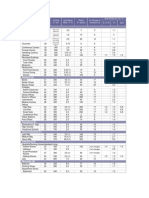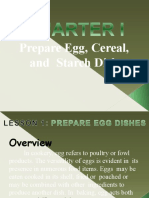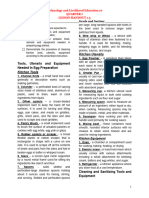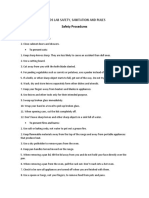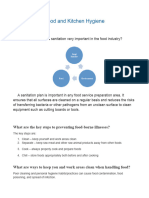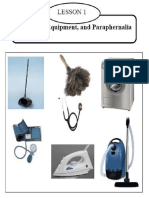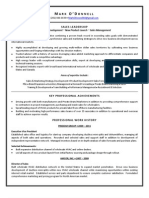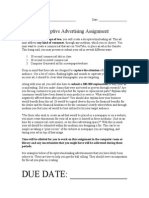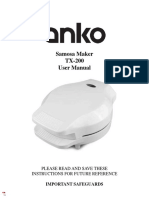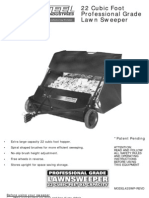Facts Sheet1
Facts Sheet1
Uploaded by
YohAnna AsakuraKyoyamaCopyright:
Available Formats
Facts Sheet1
Facts Sheet1
Uploaded by
YohAnna AsakuraKyoyamaOriginal Title
Copyright
Available Formats
Share this document
Did you find this document useful?
Is this content inappropriate?
Copyright:
Available Formats
Facts Sheet1
Facts Sheet1
Uploaded by
YohAnna AsakuraKyoyamaCopyright:
Available Formats
PREPARING EGG DISHES
This lesson introduces cooking of different egg dishes which are well-loved by everybody. Each dish has its own
way of cooking or preparing them. The preparation of egg dishes are produced using tools, utensils, and equipment as
well as ingredients. These are served in attractive forms at affordable cost to attract a lot of people.
Types of Tools, Utensils, and Equipment for Egg Preparation
1. Coddler – a small cup made of porcelain, heat proof glass or pottery with a screw on top. An egg is broken into the
cup, the top screwed on and the cup submerged in simmering water until the egg is cooked.
2. Egg Cooker – an electric appliance which steam-cook eggs in the shell.
3. Crepe Pan – a shallow, slope-sided skillet, 6 to 8 inches in diameter. Crepes can be made in almost any small shallow
pan with sloping sides. A small omelette pan will do a nice double – duty job.
4. Egg Cup – a small container designed to hold a soft-cooked egg upright in its shell for table service.
5. Custard cups – a small, deep, individual bowl-shaped dishes designed for oven use. They are useful for cooking or
serving other foods as well as custards.
6. Omelette pans – a shallow, slope-sided skillet, usually 7 to 10 inches in diameter. A double omelette pan consists of
two shallow rectangular or semi-circular pans attached by hinges.
7. Egg Piercer – a sharp-pointed tool for gently pricking a very small hole in the large end of an eggshell before hard-
cooking.
8. Egg Poacher – a rack that holds one egg-sized cups over simmering water; a small colander-like form that holds an egg
as it poaches in simmering water.
9. Quiche dish – a round, shallow, straight-sided ceramic or porcelain dish, usually with scalloped edges, for use in the
oven.
10. Egg Ring – a round band, with or without a handle, to hold a fried or poached egg during cooking.
11. Egg Scissor – a circular gadget for opening soft-cooked eggs.
12. Egg Separator – a small cup centered in a round frame made of plastic, metal or ceramic. Use to separate egg whites
from the egg yolks.
13. Egg Slicer – a device which cuts a hard-cooked egg into neat slices with one swift stroke.
14. Soufflé dish– a deep, straight – sided dish designed for oven use.
15. Wedger – similar to slicer, however, it cuts the egg into six equal parts rather than onto slices.
16. Egg Timer – used to correctly time the process of boiling eggs.
17. Egg Beater– a small device having one or usually two blades, each having several stiff oval wires at the tip.
Cleaning and Sanitizing Tools and Equipment
Types of Cleaning Agents
Not all cleaning agents can be safely used on food-contact surfaces. Examples of those cleaning agents that
should not be used are: glass cleaners, some metal cleaners, and tub and tile cleaners. The label should indicate if the
product can be used on a food contact surface. The ideal cleaning agent must be selected to make cleaning easy.
Categories of cleaning agents:
Detergents – soap in a liquid form that washes away grease, dirt, and debris from the surface. All detergents
contain surfactants that reduce surface tensions between the soil. Examples include dishwashing detergent and
dishwasher detergents.
Sanitizers – chemicals that are used after detergents. They are used to kill and reduce the number of bacteria
and spores.
Disinfectants – common household cleaning products that are suitable for toilets and floors but should not be
used on food contact surfaces and must not be used as sanitizers.
Abrasive cleaners – used to remove heavy accumulations of soil often found in small areas. The abrasive action
is provided by small mineral or metal particles, fine steel wool, copper, or nylon particles.
General Guidelines
1. Scrape off excess debris from the appliances or equipment with a scrubber sponge or scraper. Scrub everything
with hot water and antibacterial soap if you have some, if not, regular dish soap with a durable sponge will
suffice. If the equipment is wood, let it air dry.
2. Remove stains from the equipment if necessary. For wood and plastic, soak it in water then sprinkle salt onto
the stain, letting it sit for about 24 hours.
3. Sanitize your kitchen equipment. Use a large bucket or sink, and create a mixture of 1 tbsp. bleach to 1 gallon of
warm water, not hot water. Rinse with clean water afterwards and then dry with a clean towel or let it air dry.
4. 4. Store your equipment. After everything is dry, store in the proper place in your kitchen. Make sure the areas
where you are storing the equipment are clean, dry, and not overcrowded.
Sanitation – is the process of handling food in ways that are clean and healthy.
1. Wash your hands properly.
2. Always tie long hair back or wear a hat nor hairnet while cooking. Never cook in loose clothes to avoid any
accidentally catching fire.
3. Do not handle food with open sores or cut on your hand. Thin plastic gloves or finger cots are the best solutions
in this case.
4. If you are sick, do not attend to the community kitchen.
5. Pull up your sleeves to prevent your clothing from contaminating the food.
6. Wear an appropriate, clean clothing while working in the kitchen, preferably, use apron.
7. If a can is leaking, rusted, badly dented, or bulging, do not open it. Throw away. The contents may make you
sick.
8. After use, immediately wash any board and knife used for raw meat.
9. Cool food as quickly as possible before putting it onto containers to take home. This can be done by putting it
into shallow containers, and stirring regularly.
10. Foods should be refrigerated or frozen as soon as possible. Bacteria will grow if food is left out at room
temperature.
11. .It is recommended that cooked meals be kept up to three days in the refrigerator and up to three months in the
freezer.
12. When reheating meals at home, be sure to get the food up to the proper temperature, the food should be
steaming hot.
13. Thaw frozen foods in the fridge, microwave oven, or cold running water and not on the kitchen counter.
14. Follow the old saying “If in doubt, throw it out”. If you are concerned that food might be spoiled or unsafe to
eat, do not take chances. Throw it out.
15. Store knives in a wooden block or in a drawer.
16. Keep pot holders nearby and use them.
17. Do not let temperature-sensitive foods sit out in the kitchen.
18. Separate raw meat and poultry from other items whenever you use or store them.
19. When possible, use a kitchen tool instead of your hands to complete tasks.
20. Wipe up spills immediately. Keep the floor dry so that no one slips and tasks.
21. Get a fire extinguisher and first aid kit for your kitchen.
22. Repeatedly wash your hands when necessary, especially after coughing, sneezing, or using the restroom.
23. Wash dishes, pans, and utensils as you use them, allowing them to dry on the drain board when possible.
24. When tasting foods, use a spoon other than the one used for stirring. Use a clean spoon for each person tasting
and for each time food is tasted.
You might also like
- Tools, Utensils and Equipment Needed in Preparing Egg DishesDocument27 pagesTools, Utensils and Equipment Needed in Preparing Egg DishesLuzielEstradaEscalona81% (21)
- FOOD Laboratory Safety, Sanitation and RulesDocument2 pagesFOOD Laboratory Safety, Sanitation and RulesDepEdResources100% (1)
- Store and Stack Kitchen Tools and EquipmentDocument39 pagesStore and Stack Kitchen Tools and EquipmentGrace Gomez94% (18)
- Clean, Sanitize and Store Tools and EquipmentDocument105 pagesClean, Sanitize and Store Tools and EquipmentShailini Latonero100% (7)
- Prepare Egg, Cereal, and Starch DishesDocument14 pagesPrepare Egg, Cereal, and Starch DishesLen Bulgar100% (2)
- ConsumerDocument1 pageConsumerLucian NutaNo ratings yet
- Closet Planning GuideDocument8 pagesCloset Planning Guidendoan_4440% (5)
- Business Strategy For ITC Ltd.Document32 pagesBusiness Strategy For ITC Ltd.Madhusudan Partani56% (9)
- Load Check FiguresDocument2 pagesLoad Check FiguresAaron Etzkorn100% (2)
- Cookery 10 Chapter 1 Preparing Egg Dishes Lesson 1Document38 pagesCookery 10 Chapter 1 Preparing Egg Dishes Lesson 1Trisha PangilinanNo ratings yet
- Lesson 7 in TLE 8Document7 pagesLesson 7 in TLE 8Leo Nino DulceNo ratings yet
- Refrigerator: Unit 1 Major Kitchen AppliancesDocument6 pagesRefrigerator: Unit 1 Major Kitchen AppliancesFarha ShaheenNo ratings yet
- Stack and Store Kitchen Tools and EquipmentsDocument28 pagesStack and Store Kitchen Tools and EquipmentsCecille Cadano AdayaNo ratings yet
- Introduction To Kitchen Tools and EquipmentDocument4 pagesIntroduction To Kitchen Tools and EquipmentCiela TormentoNo ratings yet
- Store and Stack Kitchen Tools and EquipmentDocument24 pagesStore and Stack Kitchen Tools and EquipmentRochel MarinNo ratings yet
- CookeryDocument25 pagesCookeryGlenda Jaca100% (2)
- Quarter 3 Lesson 1 Part 2Document22 pagesQuarter 3 Lesson 1 Part 2Shara Franchesca MonterubioNo ratings yet
- Cleaning, Storing and DishwashingDocument41 pagesCleaning, Storing and DishwashingRenadel LazarteNo ratings yet
- Gr.9 LO1Document50 pagesGr.9 LO1gracemelody.velasco.xNo ratings yet
- How To Clean and Store Cooking Tools and EquipmentDocument6 pagesHow To Clean and Store Cooking Tools and EquipmentMadea MadeaNo ratings yet
- Learner'S Packet No. 3 Quarter 1: Name of Student: Learning Area/Grade Level: Date: Week 3 Activity TitleDocument7 pagesLearner'S Packet No. 3 Quarter 1: Name of Student: Learning Area/Grade Level: Date: Week 3 Activity TitleSalgie MasculinoNo ratings yet
- Important Terms Used in The KitchenDocument4 pagesImportant Terms Used in The KitchenyzNo ratings yet
- Tle Cookery 1st QuarterDocument2 pagesTle Cookery 1st Quarterpeteclarenzbinarao.25No ratings yet
- Food Management Basic RevisedDocument16 pagesFood Management Basic Revisedyenling456No ratings yet
- Introduction To Cookery Ncii: Cooking-The Act of Using Heat To Prepare Food For ConsumptionDocument5 pagesIntroduction To Cookery Ncii: Cooking-The Act of Using Heat To Prepare Food For Consumptionfranco jocsonNo ratings yet
- Quarter 1 Lesson 3Document44 pagesQuarter 1 Lesson 3Cara Mae RamosNo ratings yet
- Procedure For Disinfecting PremisesDocument26 pagesProcedure For Disinfecting PremisesHannah AlbisNo ratings yet
- Prepare Egg, Cereal, and Starch DishesDocument14 pagesPrepare Egg, Cereal, and Starch DishesGlyza Marie CendanaNo ratings yet
- Module 1 LESSON 3Document20 pagesModule 1 LESSON 3Anne Rose CoderiasNo ratings yet
- Kitchen Accidents & PreventionsDocument17 pagesKitchen Accidents & Preventionschefsachin100% (1)
- To Print Mod1Document4 pagesTo Print Mod1clothesanddreams88No ratings yet
- How To Clean and Store Cooking Tools and EquipmentDocument4 pagesHow To Clean and Store Cooking Tools and EquipmentKyRRa SiMNo ratings yet
- Tle 10 - Handout 1.3Document2 pagesTle 10 - Handout 1.3Danica PerezNo ratings yet
- Foods Lab SafetyDocument3 pagesFoods Lab SafetyCarlo CaxNo ratings yet
- Eilennnnn Edep H.Document53 pagesEilennnnn Edep H.Juncarl Guinoo30No ratings yet
- Preventing Cuts and Burns: VELARDE, Mark John Villiadolid, BradleyDocument15 pagesPreventing Cuts and Burns: VELARDE, Mark John Villiadolid, BradleyGezelle NirzaNo ratings yet
- Tle 11-Steps in Washing DishesDocument9 pagesTle 11-Steps in Washing DishesArgie Mecolita0% (1)
- Week 002 CLEAN AND MAINTAIN KITCHEN TOOLS, EQUIPMENT, AND PREMISES (Part 2)Document24 pagesWeek 002 CLEAN AND MAINTAIN KITCHEN TOOLS, EQUIPMENT, AND PREMISES (Part 2)itsmeshiellamedalloNo ratings yet
- Grade 8 Lesson CleanDocument36 pagesGrade 8 Lesson CleanMary Joy LanuzaNo ratings yet
- Steps in Cleaning Kitchen PremisesDocument2 pagesSteps in Cleaning Kitchen PremisesJeaunesse Anne Perez NavarroNo ratings yet
- Grade 7 Mod. 3Document18 pagesGrade 7 Mod. 3Lucille Paglingayen100% (1)
- Group 3 SanitizingDocument14 pagesGroup 3 SanitizingChieza Ann QuinapondanNo ratings yet
- Cleaning Kitchen PremisesDocument44 pagesCleaning Kitchen PremisesJHEN TULAYLAYNo ratings yet
- Store and Stack Kitchen Tools and EquipmentDocument2 pagesStore and Stack Kitchen Tools and Equipmentivy l.sta.mariaNo ratings yet
- Prevention of Food Borne IllnessDocument4 pagesPrevention of Food Borne Illnessknowledgezone8242No ratings yet
- Ama Cook Module 3 Storing and Stacking Tools and EquipmentDocument25 pagesAma Cook Module 3 Storing and Stacking Tools and EquipmentDatchies OplasNo ratings yet
- CLEANING THE KITCHENDocument18 pagesCLEANING THE KITCHENKristine Joy KatigbakNo ratings yet
- How cleAN and Store Equipment (Autosaved)Document14 pagesHow cleAN and Store Equipment (Autosaved)Herlidyn CapinpinNo ratings yet
- Perform Aftercare Activities For ToolsDocument27 pagesPerform Aftercare Activities For ToolsJolina BandinNo ratings yet
- Store and Stock Kitchen Tools and EquipmentDocument15 pagesStore and Stock Kitchen Tools and Equipmentarniel antipuestoNo ratings yet
- 15 Most Essential Kitchen Tools and Equipment You Should Never MissDocument4 pages15 Most Essential Kitchen Tools and Equipment You Should Never Missjohn mampustiNo ratings yet
- Comm'l Cooking HandoutDocument8 pagesComm'l Cooking HandoutEuropez AlaskhaNo ratings yet
- Kitchen SafetyDocument13 pagesKitchen SafetyLloyd S. EvardoNo ratings yet
- Cookery Major Group 1 12 MantosDocument88 pagesCookery Major Group 1 12 MantossedurifaangieleNo ratings yet
- Kitchen Utilization and Proper Handling of ToolsDocument16 pagesKitchen Utilization and Proper Handling of ToolsChesca Camille Marzan Bautista - BagnolNo ratings yet
- Food Technology Information BookletDocument16 pagesFood Technology Information Bookletaakot460No ratings yet
- Store and Stack Kitchen Tools and EquipmentDocument5 pagesStore and Stack Kitchen Tools and EquipmentMary Rose SilvaNo ratings yet
- Kitchen EssentialsDocument18 pagesKitchen Essentialshibiscus-eurie montillanaNo ratings yet
- Food and Kitchen Hygiene Paprint Angeline1Document6 pagesFood and Kitchen Hygiene Paprint Angeline1Dang CabaticNo ratings yet
- Guide Food Processing LabDocument7 pagesGuide Food Processing LabPet Anthony PascualNo ratings yet
- Caregiver TOOLSDocument28 pagesCaregiver TOOLSKirsten KateNo ratings yet
- Notes On Personal and Kitchen HygieneDocument6 pagesNotes On Personal and Kitchen HygieneDaniellea Powell100% (1)
- How to Clean Kitchens And other things your Mom should have taught you about CleaningFrom EverandHow to Clean Kitchens And other things your Mom should have taught you about CleaningRating: 5 out of 5 stars5/5 (1)
- Free Prrintable Parent Discipline Letter Template ExampleDocument6 pagesFree Prrintable Parent Discipline Letter Template ExampleYohAnna AsakuraKyoyamaNo ratings yet
- Free Prrintable Parent Discipline Letter Template ExampleDocument6 pagesFree Prrintable Parent Discipline Letter Template ExampleYohAnna AsakuraKyoyamaNo ratings yet
- Daily Cleaners: FridayDocument3 pagesDaily Cleaners: FridayYohAnna AsakuraKyoyamaNo ratings yet
- Date: Time: Grade: Section: Number of Students: Grading PeriodDocument2 pagesDate: Time: Grade: Section: Number of Students: Grading PeriodYohAnna AsakuraKyoyamaNo ratings yet
- Gardenia Bakeries Philippines IncDocument33 pagesGardenia Bakeries Philippines IncTrisha CabralNo ratings yet
- Men StyleDocument12 pagesMen StyleTheCosmicFlowNo ratings yet
- VP Business Development Sales in NYC Resume Mark O'DonnellDocument2 pagesVP Business Development Sales in NYC Resume Mark O'DonnellMarkODonnell1No ratings yet
- Indian SparesDocument10 pagesIndian SparesH2M2 Indian FoodsNo ratings yet
- TYPES OF TOOLS For EggsDocument18 pagesTYPES OF TOOLS For EggsFerdinand Hernani100% (1)
- Viking Immersion Suits Service MannualDocument100 pagesViking Immersion Suits Service MannualAhmed Araby HassanNo ratings yet
- Young Mens and Casual Wear.Document21 pagesYoung Mens and Casual Wear.ARUN KUMAR VELUPUKONDANo ratings yet
- Deceptive Advertising AssignmentDocument2 pagesDeceptive Advertising Assignmentapi-277766829No ratings yet
- THORDocument20 pagesTHORRayensita100% (3)
- ANKO Quesadilla Maker NoticeDocument7 pagesANKO Quesadilla Maker NoticeSYLVIENo ratings yet
- Escorting & RoomingDocument41 pagesEscorting & RoomingJustin PangNo ratings yet
- Vietnam Retail Market Report - EuroasiaDocument41 pagesVietnam Retail Market Report - EuroasiaNha Nguyen HoangNo ratings yet
- NEW JERSEY - Restaurantes de Bandera Peruana: Peruvian Cuisine For The WorldDocument8 pagesNEW JERSEY - Restaurantes de Bandera Peruana: Peruvian Cuisine For The WorldJorge Yeshayahu Gonzales-LaraNo ratings yet
- The LandladyDocument8 pagesThe LandladyLotte ter HaarNo ratings yet
- My Rate Chart PDFDocument4 pagesMy Rate Chart PDFSudipta OfficialNo ratings yet
- HPC 1 Rubrics Final LabDocument3 pagesHPC 1 Rubrics Final Labcelestetorino1No ratings yet
- Interview MTR FoodsDocument17 pagesInterview MTR FoodspranjalNo ratings yet
- Heizer 09Document77 pagesHeizer 09waknaqiNo ratings yet
- SCM Amazon ProfilingDocument14 pagesSCM Amazon Profilinggaurav2616146No ratings yet
- Ice Breakers Cheeky-Cheeky: Submitted by Amy Sandison, Gotel MinistriesDocument9 pagesIce Breakers Cheeky-Cheeky: Submitted by Amy Sandison, Gotel MinistriesStef TomaNo ratings yet
- 42SWP22 Lawn SweeperDocument12 pages42SWP22 Lawn SweeperPurpleRyderNo ratings yet
- Electra Woman AND Dyna Girl: PilotDocument40 pagesElectra Woman AND Dyna Girl: Pilotcostin dNo ratings yet
- Essential Clutch FinalDocument7 pagesEssential Clutch FinalLaura Nardi100% (2)
- Exercise No. 3, 4, 5Document13 pagesExercise No. 3, 4, 5Quinnee VallejosNo ratings yet
- Jeet KaushikDocument91 pagesJeet Kaushikjitendra jaushik100% (1)
- Godiva PDFDocument2 pagesGodiva PDFsamir100% (1)








